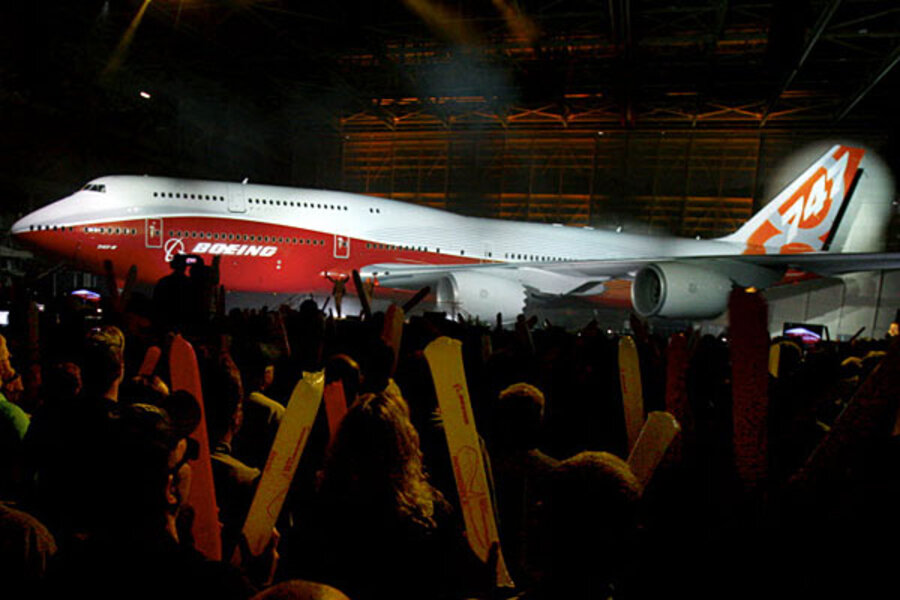747-8 Intercontinental ready for primetime
Loading...
Boeing Co (BA.N) rolled out a new jumbo jet on Sunday, hoping to relive the glamour of the birth of the 747 over 40 years ago and use it to boost slow sales.
The 747-8 Intercontinental will seat 467 passengers, 51 more than the current version of the 747, and burn less fuel while offering passengers more comfort, the U.S. planemaker says.
"Of all the airplanes that we've built, there is one that is identified more closely with Boeing than any other, and that's the 747," said James Albaugh, head of Boeing's commercial airplane unit, introducing the plane to a crowd of almost 10,000 Boeing employees, their families and a select group of industry VIPs.
The event took place in the same hangar at Boeing's Everett plant outside Seattle where the first jumbo made its debut in 1968.
Near the front of the seated audience was Joe Sutter, Boeing's chief engineer on the original jumbo, and known as the "father of the 747."
The plane itself, unveiled from behind an enormous curtain to rapturous, thudding music, was bright red and white -- a departure from Boeing's recent blue -- bearing generic Boeing livery on the side and '747' on its orange tail.
The unveiling came almost 42 years to the day since the maiden flight of the 747, which went on to become the world's most recognized jetliner and transformed the global travel industry.
It is the first appearance of a radically new version of the passenger jet since the first jumbo, with its humped two-storey cabin and 196-foot (69-meter) wingspan, took the world's breath away on a sunny morning at Everett in September 1968.
"People were awe-struck. It was a monster, nobody had seen anything like it," said Jim Mullins, a Paris-based science writer who covered the original rollout for King Broadcasting.
"Today it looks ordinary, but at that time there were no airplanes even close to it in size. They opened up the hangar doors and it was just unbelievable. People reacted as if they were rolling out the Empire State Building."
The 747 lost its crown as the world's largest airliner when the 525-seat Airbus (EAD.PA) A380 was unveiled in 2005. But at 19 feet longer than its predecessors, this one will be the longest.
It is the first time the 747 fuselage has been stretched to make the biggest passenger jet marketed by a U.S. manufacturer.
The 747-8 -- listed at $317.5 million -- also boasts new wings, a new tail, state-of-the-art engines and a new cockpit, making it, according to specialist magazine Flight International, "unrecognizable from that first jumbo jetliner."
SLOW SALES
However, big is not yet beautiful for the Boeing order book.
Despite its hopes of securing a new lease of life for the 747 family, Boeing has so far managed to win 33 orders for the 747-8 passenger version including just two airlines -- Germany's Lufthansa (LHAG.DE) and Korean Air Lines (003490.KS).
The first delivery will be to an unnamed VIP customer instead of an airline late this year, but Boeing has said it is confident of winning new orders as the plane enters service.
Pat Shanahan, Boeing's general manager of airplane programs, said he expects sales to pick up this year and was encouraged by stronger sales of the freighter version of the aircraft, speaking to reporters after the unveiling.
"This would make a great airplane for our president," Shanahan added, in the hopes that the plane will eventually replace the two older 747s currently serving as Air Force One. "We'd be happy to build one."
Lufthansa, which expects to start operating its new 747s from early 2012, is not concerned that it is one of only two airlines signed up to buy the plane, Nico Buchholz, head of Lufthansa's fleet management, said at the event.
The new 747 was not meant as a replacement for the A380s his airline already operates, Buchholz said, but would fill the gap between its mid-sized planes and the 500-plus-seater market catered for by the A380.
He did say that the A380 worked out slightly more economical on a cost-per-seat-mile basis than the new 747, assuming the planes are full.
PRODUCTION DELAYS
Production of the new 747 has been delayed as the 787 Dreamliner, a carbon-composite plane which represents a bigger leap in technology than the revamped 747-8, diverts engineering time.
Boeing says the first 747-8 that the public will get to fly on will be delivered to Lufthansa in 2012.
The stronger-selling freighter version, which has already taken flight, is due to be delivered in mid-2011 -- 18 months later than first planned. Boeing has sold 74 747-8 freighters.
Both Boeing and Europe's Airbus have suffered multiple plane project delays, damaging their credibility, say many analysts.
Sales of earlier generations of the 747 far soared above the industry's initial expectations, with more than 1,400 classic jumbos sold until the 747-400 was withdrawn from sale last year.
Although the 747-8 and A380 will compete directly for years to come, analysts say airlines are mostly interested in lighter, wide-bodied planes in the 200- to 350-seat range, like the 787 and the future Airbus A350, which are designed to bypass crowded hubs and take passengers closer to their final destination.
Boeing will give an update on the delayed 787 on Monday.





